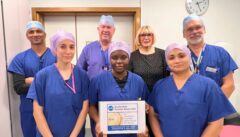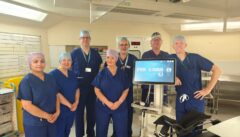Contents
Barrett’s Oesophagus

Barrett’s Oesophagus – Causes, Symptoms and Monitoring
Understanding Barrett’s oesophagus
Barrett’s oesophagus is a condition where the normal lining of the food pipe (oesophagus) changes, usually after many years of acid reflux or heartburn. While most people with Barrett’s do not develop serious problems, a small number may develop abnormal cells (called dysplasia) which, if untreated, can increase the risk of oesophageal cancer. Regular gastroscopy (endoscopy) helps us detect these changes early and keep you safe.
How is Barrett’s oesophagus diagnosed?
Diagnosis is usually made with a gastroscopy, a short day-case procedure where a thin flexible camera is gently passed into the oesophagus. The consultant carefully inspects the lining, records measurements and may take small tissue samples (biopsies). This allows accurate diagnosis and helps decide whether monitoring is needed.
Do I need regular endoscopy?
Not everyone with reflux or heartburn develops Barrett’s, and not everyone with Barrett’s needs frequent checks. The timing of follow-up depends on the length of the Barrett’s segment and whether any abnormal cells are seen. Your surveillance schedule will always be tailored to your individual needs. Your endoscopy consultant will recommend the right interval based on international and UK guidelines.
What happens if abnormal cells are found?
If biopsies show dysplasia or very early cancer confined to the lining, modern endoscopic treatments can often remove or treat these cells without major surgery. If this is required, it will usually be arranged in association with, or by referral to, a specialist centre with expertise in these procedures. Your consultant will guide you through the process to ensure you receive the most appropriate care.
When should I seek medical advice sooner?
If you develop any of the following between scheduled appointments, please see your GP or gastroenterologist promptly:
- Difficulty swallowing food or liquids
- Persistent chest or upper tummy pain
- Vomiting blood or passing black stools
- Unexplained weight loss
Why monitoring matters
- Detects early changes when they are most treatable
- Reduces the long-term risk of oesophageal cancer
- Offers reassurance when no concerning changes are found
Is gastroscopy safe?
Yes. Gastroscopy is a very safe and widely performed test. Most patients only experience a mild sore throat or temporary drowsiness from sedation. Rarely, complications such as bleeding or a small tear may occur. Your consultant will always discuss the risks and benefits with you before the test.
How can I help myself?
Lifestyle measures and medication can help reduce acid reflux and support your overall health:
- Take acid-suppressing medication if prescribed
- Maintain a healthy weight
- Stop smoking and limit alcohol
- Raise the head of the bed and avoid eating late at night
- Attend your scheduled check-ups
Expert care you can trust
At this hospital, care for Barrett’s oesophagus follows the latest European and UK guidance. Endoscopists such as Dr Udit Mittal, Consultant Gastroenterologist, use high-definition endoscopy and evidence-based protocols to provide safe, personalised care. If additional specialist treatment is required, referral to expert centres will be arranged seamlessly.
This information is for general education only and should not replace personalised medical advice. Please speak to your doctor or endoscopy consultant about your own care plan
1 October 2025




